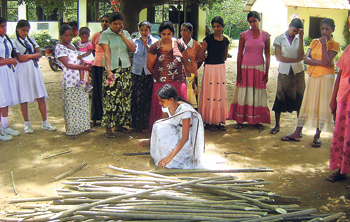Ask Laknath Pieris why he believes in social entrepreneurship and don’t expect him to pull his punches: “Most people think that the responsibility for addressing social problems lies with the government. However, the complexity of most social problems calls for more than one response and more than one solution.”
His approach: Education with a decidedly entrepreneurial and managerial focus. “I believe, to reduce inequality, we have to create economic opportunities as well as entrepreneurship and management skills. In the past, the government had created economic opportunities but the missing link was the entrepreneurship and management skills,” suggests Mr. Pieris.
 |
| The gliricidia project |
Social entrepreneurship may also be the only working model for this era: “When globally 94% of income goes to 40% of people and 60% of people live on 6% of income and when half of the world lives on less than Sri Lanka Rs. 100 a day… Social enterprise is the only business model which offers the prospect of a greater equity of economic power and a more sustainable society – by combining market efficiency with social and environmental justice,” he adds.
It is important to note that not only is Mr. Pieris a proponent for social entrepreneurship, but he is also a trailblazer in the field. He is Founder/Director of Savijana – a non-governmental organization registered with the Ministry of Social Welfare with the stated mission of ‘the reduction of poverty and inequality by building grassroots knowledge based societies’. A social enterprise which he founded after a notable career which started at Ernst & Young in 1987 and culminated with stints as Vice President – Finance at Asia Capital in 2001 and Director at Synergy Management Consultants in 2006.
Mr. Pieris’s fledgling social enterprise, Savijana, is a direct response to what he believes is his duty: “Most of us talk about rights but forget about our duty towards society. Most professionals perform good deeds through charity or religious activities. But very few do so in a sustainable and systematic manner and I oppose just handouts, but I am for investing in people to achieve economic success… We all know the inequality and standard of living of people at the lower income levels of society and we talk about poverty, but that’s it. We do not do much and we expect the government to do things for the poor. I believe every one has a duty to give these people a chance to better their lives. That’s why I founded Savijana.”
In deciding on an appropriate model for social enterprise, Mr. Pieris says he first considered macro factors such as population density, geographical area, etc. and then he started looking at the people at bottom tiers of income generation and the problems, skills, needs and abilities unique to them. He then came up with three areas on which Savijana could focus: Micro Finance and Business Development, Agro Development, and Education.
Multiple initiatives were undertaken because of Mr. Pieris’s belief that Micro Finance alone was not enough to improve the standard of living although many benefited from the practice. As it was also necessary to create opportunities which could be scalable into the future and considering factors as diverse as local rural sectors and impending world food scarcity, Savijana has most recently evolved its model to include Agro Development. Now promoting the easy-to-grow Gliricidia crop, the organization uses schools as a conduit for educating students and their parents as well as a base for its distribution. Through this method, Gliricidia’s multiple benefits, such as fuel for home burning and its high efficacy as fertilizer, are being disseminated among communities.
To many the most important question may ultimately be: Is the Savijana model successful? We will have to wait and see. Two years, it seems, is not enough time for a social enterprise to grow according to Mr. Pieris. However, the model has made significant progress with a strong grassroots network slowly falling into place and many of Savijana’s projects set to continue to grow. Mr. Pieris is also confident that sustainability for many or even all projects will be achieved within the next two to three years. He points to Savijana’s success in facilitating community involvement as its strongest achievement to date. What’s next for Savijana? “I want to concentrate on promoting Savijana and build a solid network of individuals, corporates and development agencies to invest in my concept”, says Mr. Pieris. Meanwhile, at the same time that he has been developing Savijana as a model social enterprise, Mr. Pieris has also been endeavouring to raise awareness and provide advisory services to promote the social enterprises sector.
He believes that the way forward will require fostering a culture of social enterprise, especially inspiring the next generation to start thinking about the social impact of business.
The quality of business advice and support available must also be improved while barriers to the access of finances must be addressed and social enterprises must be allowed to work with governments to develop policies for this area.
|

